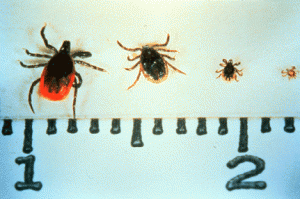Lyme disease is the most common insect-carried disease in Maine. Ticks are already out and we expect the number of Lyme disease cases to increase as the weather continues to get warmer, said Dr. Sheila Pinette, Maine Center for Disease Control Director and Dr. Stephen Sears, State Epidemiologist. They say that Anaplasma, Babesia and other tick borne diseases are also increasing in Maine, though Lyme disease is the most frequent tick borne illness.
 Lyme disease is a bacterial infection that is carried by the deer tick, Ixodes scapularis. Cases of lyme disease increased over the last five years in Maine, and occured in all 16 counties. Lyme disease is most common among adults aged 45 – 64, but school age children 5 – 14 also have high numbers of cases. Most infections occur during the summer months. As the weather continues to get warmer, more ticks will be out in the open, and we are likely to see more cases of Lyme disease. Over 1,000 cases of Lyme disease were reported statewide in 2011, which is a record high for Maine. Over 100 cases have already been reported so far in 2012, and that number will continue to rise as we enter the summer months.
Lyme disease is a bacterial infection that is carried by the deer tick, Ixodes scapularis. Cases of lyme disease increased over the last five years in Maine, and occured in all 16 counties. Lyme disease is most common among adults aged 45 – 64, but school age children 5 – 14 also have high numbers of cases. Most infections occur during the summer months. As the weather continues to get warmer, more ticks will be out in the open, and we are likely to see more cases of Lyme disease. Over 1,000 cases of Lyme disease were reported statewide in 2011, which is a record high for Maine. Over 100 cases have already been reported so far in 2012, and that number will continue to rise as we enter the summer months.
You get Lyme Disease when you’re bitten by an infected tick. Ticks like tall grass but can be found in any area. Tuck pant cuffs into b0ot or socks, and closely inspect your clothing and body for ticks after every stroll around your garden, at the playgrounds or playing fields, or after every walk in the woods. Inspect pets as well. Ticks have to bite you for 24 hours before they pass the disease, so showering and scrubbing with a wash cloth after spending time in the garden is a good idea before bed. Most tick bites will not result in Lyme disease, but read on for symptoms.
Lyme Disease Symptoms
The most common early symptom of Lyme disease is an expanding red rash that occurs at the site of the tick bite within 3-30 days after being bitten. Fever, joint and muscle pains may also occur. Lyme disease is treatable, and the majority of patients recover after receiving the right therapy.
Lyme Disease Treatment: What to do after a tick bite
- Remove the tick properly, ideally using tweezers or a tick spoon.
- Identify the tick and the engorgement level, or how long it was attached to you. Tick identification is available through the Maine Medical Center Research Institute and more information can be found there.
- Clean the area around the bite, and watch for signs and symptoms for a whole month.
- Testing of the tick is not usually recommended because even if the tick tests positive for Lyme, that does not mean it was attached long enough to transmit disease, and even if the tick tests negative that does not mean that was your only exposure, and that does not eliminate the possibility of Anaplasmosis or Babesiosis.
Tick Bite Treatment
Treatment after a tick bite is not routinely recommended, but can be considered under specific circumstances including:
- Tick has been identified as an engorged deer tick that has been attached for over 24 hours
- Exposure occurred in an area where there is a high rate of infected ticks. Areas south of Bangor have the highest rate of infected ticks in the state. There is limited data from the more northern counties on the rate of infection among ticks.
- Preventive treatment can be started with 72 hours. Even if preventive treatment is used, watching for symptoms for 30 days is recommended.
Other tick borne diseases
Other diseases that are carried by ticks in Maine include Babesiosis and Anaplasmosis. Symptoms of Anaplasma include: fever, headache, tiredness and body aches. Symptoms of Babesia include: extreme fatigue, aches, fever, chills, sweating, dark urine, and possibly anemia.
In 2011, doctorss reported 26 cases of Anaplasmosis. Doctors have already reported seven cases in 2012. In 2011, doctors reported 9 cases of Babesiosis. No cases have been reported so far in 2012. Anaplasmosis, Babesiosis, Ehrlichiosis and Rocky Mountain Spotted Fever are all reportable in Maine.
For more information on tick borne diseases including Lyme visit this section at the Maine state website.